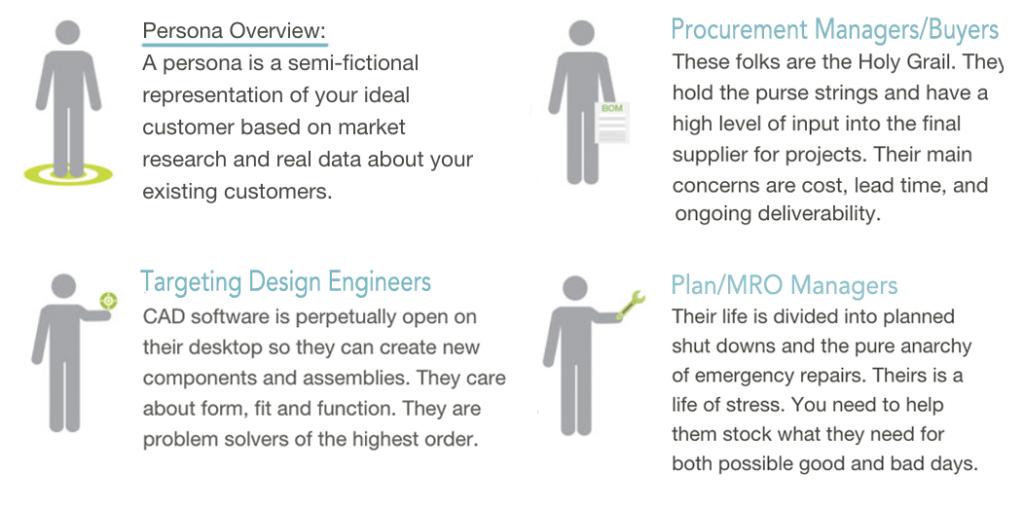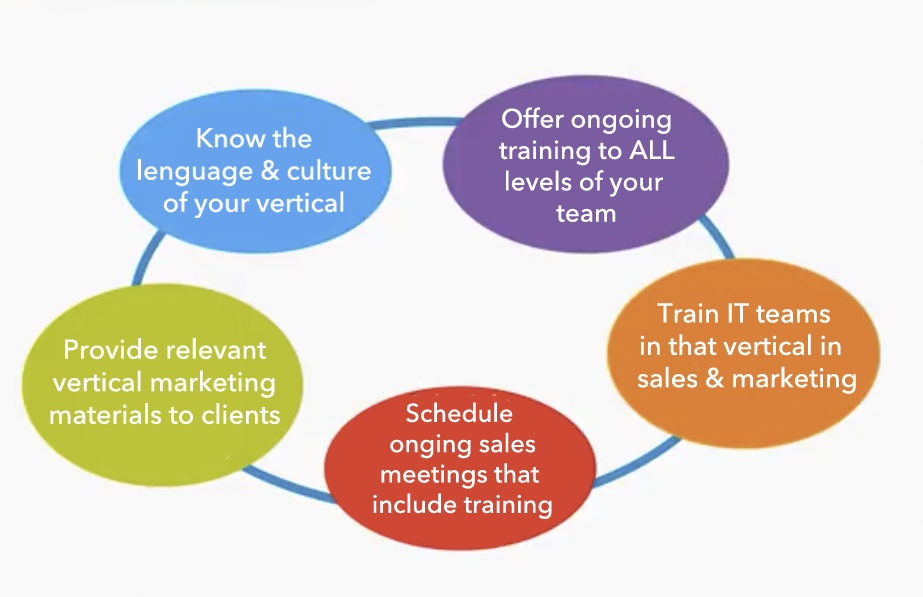Seth Godin, an American author and former dot-com business executive once said, “Everyone is not your customer.”
If your company provides a Horizontal Market, then chances are your targeted industry is quite broad. For small or mid-size businesses this could cost the company time and resources that perhaps could be allocated elsewhere.
In this article, we’ll go over five steps to select, enter, and develop a vertical market that will allow your company to be more competitive and generate growth by monetizing it in a vertical market.
You can skip through this guide sections with the links below
1. Select your market vertical
2. Create a Client Profile (industrial personas)
3. Estimate Market Value (local or global)
4. Making a real commitment to your vertical
5. Develop training programs
.
Focusing on a specific market doesn’t have to be something only vertical market-oriented companies do. Horizontal companies can, too. Your product, your services, and your business isn’t for everybody. What I have seen after more than a decade working with companies in different industries is that the companies with the biggest success, in the beginning, have a well-established niche (vertical) business with a targeted audience.
If you provide communication services or products, there might see a general enough blanket that it could cover everyone, but realistically companies that specialized in providing communications services to a certain niche (vertical) like healthcare, Finance, energy, and education are going to see their investment go further in a shorter amount of time.
Communications or IT sales scenario
For example, a hospital or healthcare provider will rather buy services from a company that has expertise in the common problems that they face, such as mission-critical communications systems, security, and so on, than just trust a company that generalizes in Telecom overall.
There are numerous vertical markets such as Retail, healthcare, legal, education and so forth, and these can be broken down into smaller categories or sub-niches, also called micro-verticals. For example, let’s say that you are interested in Retail, a sub-niche would be food delivery truck companies.
Benefits of entering a vertical market:
Highest Revenues: Existing clients will begin to bring new accounts. The more clients you bring in the higher your revenues.
Better Margins: As your sales and technical team builds a repeatable process, your cost of implementation will decrease.
Lower Cost of Sales: As your sales team become more educated and your marketing messages more concise, your marketing dollars begin to go further.
For example: Target your sales and marketing efforts towards specific industry challenges and the solutions you provide.
Lower Cost of Implementation: As your technical team builds a repeatable process, your cost of implementation will decrease. Focusing on a specific vertical market will lead to faster and more profitable business growth.
.
.
Technical implications
As your technical teams build a repeatable process, your cost of implementation decrease. In other words, by focusing on a specific market, you open the door to more profitable business growth.
Market Penetration: Entering a new market
Market Development: Using an existing market your organization uses already but turning it into a niche.
.
VERTICAL MARKET PENETRATION & DEVELOPMENT
Entering a new market and honing in on a specific niche might sound like a scary proposition, and even overwhelming for some people, to try and to put this all together. In other words, you are putting all your eggs in one basket, especially when you are trying to maintain your current business. But with a solid plan, you can become that dominate provider to your chosen vertical market.
1. Select your market vertical
- To make it easy, start by selecting your existing customer base– some are already aligned in a specific vertical, and look for patterns.
- Create a simple spreadsheet with columns for the following: sector (industry), revenue number, information of services provided, and appropriate solutions.
- Then read and learn industry trends and knowledge within your new vertical.
CompTIA is a great industry trends tool do research on your vertical. Also, you can look into publications, thought leaders in that industry, etc. - Lastly, Choose a viable market, one that is showing growth and opportunity that can benefit your organization’s goals.
.
Six popular vertical markets and their needs
1. Retail
2. Healthcare
3. Banking
4. Manufacturing
5. Education
6. Government
Retail: Need better customer service: Mobile POS systems, tables, reliable communications, and wireless solutions.
Healthcare: Have shortage of nurses and health practitioners. Providers need wireless technologies, mobile, secure storage, systems integration, IoT technologies, and communications systems.
Banking: Fastest growing market: Institutions require increased bandwidth, security, and technological infrastructure.
Manufacturing: Improve manufacturing effectiveness to reduce production costs, performance analytics tools, efficiency and quality monitoring, security and cloud applications.
Education: It has suffered from reduced funding similar to the government industry: It needs technological solutions to save money or growth enrollment; Online course delivery and wireless technologies.
Government: Looking for cost reduction solutions, and secure communications.
Consideration Analysis
When considering a vertical, the number one thing I recommend is to think about how your own organization operates.
- First, what is your added value to that vertical?
- Understand your organizational needs and capabilities
- Then look at your organization as a whole and consider any specialized skills or expertise needed to be successful in that vertical. Does your current staff have that expertise? Are you going to have to hire more staff, or can you use what you already have? Perhaps, you could train your staff, then you want to factor that cost to add it to your revenue projections.
- Write down existing clients in similar vertical markets.
- Factor additional costs associated with focusing on the vertical into your revenue projections.
- Research Market opportunities in that vertical with a SWOT Analysis.
SWOT ANALYSIS:
The typical SWOT ANALYSIS helps to analyze the internal and external factors.
Find out the current size of the market and how much growth is expected in that particular area. In other words, does the vertical seem to be growing or shrinking?

SWOT Analysis will help you in finding sub-niches or micro-verticals in that area. Focus on sub-niches can be beneficial because it can easily reduce your costs even further
One thing I always recommend to my clients and the CEOs I have worked for is to develop a Business Analysis Report. I wrote this extensive article, so please take the time to read it. It will be a great tool for your business to have.
2. Create a Client Profile (Personas):
Be clear about who your target market is. This is also called business Personas.
Ask the following questions:
- What do these clients have in common?
- What are their pain points?
- What tools or services can you provide to fix clients’ issue
Most executives are happy to answer questions about their challenges that can help formulate a plan, so talk to them–not a sales pitch– just ask, “tell me aobut your industry.”
.
How to collect this data:
One way to do this is by surveying your prospective clients, but that can be quite expensive. One way to do this is by utilizing pooling tools available on social media platforms and databases. I wrote an article about Target Market Personas with all the information, tools and examples on how to go about creating them.
PERSONAS: The profile of your target audience (s)
.
.
Let’s take a look at the most common industrial personas targeted by manufacturing businesses.
For manufacturing companies, there are three main types of personas you’ll want to create, as they directly influence the industrial buying cycle.
Industrial Targeted Market

With a clear concept of your vertical market and the ideal client profile, you will be ready to determine what steps you’ll need to take to successfully focus on that chosen vertical.
3. Estimate Market Value (local or global)
Market research on prospective clients doesn’t have to be expensive or time-consuming. This information will provide you with the basics for desition making and whether or not this is an opportunity worth pursuing, in that making sure the industry trend is not only moving in the right direction but if it’s going to be profitable for your organization.
Research prospective clients in that vertical. Use LinkedIn, industry-specific review sites to narrow down the pool, narrowing those results in the list to include only those that fit your client profile— will begin to give you a good and clear picture of how viable that client geolocation and more effective for your organization.
Every contact is not a business opportunity is a relationship opportunity
Another thing you want to do is networking with the main players in your vertical space. Other companies may be operating successfully in your niche but are not a competitor to you.
Industrial Market Research
The basis for anticipating likely future market demand lies in thorough industrial market research, which some in the industry identify as a key business tool in reducing risk and increasing sales. I recommend obtaining The Industrial Market Research Handbook – Amazon. Design for sales and marketing managers, company directors and practically anyone who needs to be fully informed of the latest developments and techniques, this practical handbook is a complete guide to analyzing, assessing and anticipating the strength of the industrial market in almost every area of business.
.
4. Make a real commitment to your vertical
a) Organizational commitment
b) Explore industry culture and influencers
c) Study their workflow
d) Become an expert in compliance and regulatory issues in their region.
Committing to a vertical goes beyond just creating a business plan. You have to make a conscious commitment that you, your team and your entire organization is going to be the focus on becoming the dominant player in that chosen vertical.
Explore industry culture
Immersing yourself in the vertical is more than just understanding the business side things.
- Explore the industry culture
- learn its nuances
- who are the potential influencers and desition makers
- Read Industry insiders articles
- Talk to lower and middle-level employees about the challenges they have
Study their workflow
Study the workflow, the processes, and procedures that they use to generate revenue for their business.
Often times we focus on how is going to benefit us, but we really need to benefit the company that we are trying to sales to and provide services to and how is going to help their button line. In other words, understanding your client’s business workflow, you will be able to offer technology solutions to make those workflows more efficient.
Learn the specialized technologies that they use, so not only not only is about what you can provide but how does that interconnect in some of the other software, hardware or systems that are unique to that vertical; and who are the key players currently in the market. Of course, this is going to make you sound more credible when you are trying to sell your product that may be connected to theirs.
Lastly, become an expert in the ever-changing compliance and regulatory issues in the region you serve. How these affect your systems and the implementation of those.
,
5. Develop training programs
Traning your employees to understanding the language and culture of your vertical at a professional level, not only it allows your sales, technical, and marketing teams to have cross-functional activities that are synergetic, but it creates a process that is relevant to your clients. In addition, it allows your organization to develop marketing and sales materials that are professional and easy to automized across all departments of your organization. All team member and stakeholders should understand the vertical’s league and culture, and aline that with the company’s brand and product goals.

NEXT>>PART TWO OF THIS ARTICLE: AGILE INDUSTRIAL MARKETING
